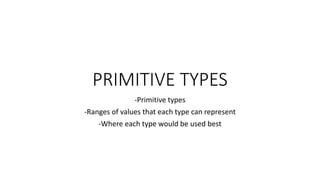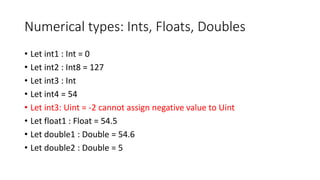Primitive types
- 1. PRIMITIVE TYPES -Primitive types -Ranges of values that each type can represent -Where each type would be used best
- 2. Numerical types: Ints, Floats, Doubles • Let int1 : Int = 0 • Let int2 : Int8 = 127 • Let int3 : Int • Let int4 = 54 • Let int3: Uint = -2 cannot assign negative value to Uint • Let float1 : Float = 54.5 • Let double1 : Double = 54.6 • Let double2 : Double = 5
- 3. Boolean : true/false • Let bool1 : Bool = false • Let bool2 : Bool = 5 > 3 • *testing condition
- 4. Character • One digit in length, between “ “ • Let char1 : Character = “?” • Let char2 : Character = “ ©“ • Let char3 : Character = “5” just a character, not number • Let char4 : Character = “ “ not allowed




